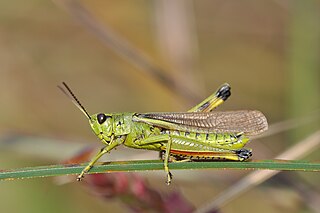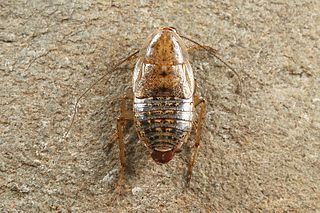Related Research Articles

Forficula auricularia is a species complex comprising the common earwig. It is also known as the European earwig. It is an omnivorous insect belonging to the family Forficulidae. The name earwig comes from the appearance of the hindwings, which are unique in their resemblance to human ears when unfolded. The species name of the common earwig, auricularia, is a specific reference to this feature. The European earwig survives in a variety of environments. It is also a common household insect in North America. They are often considered a household pest because of their tendency to invade crevices in homes and consume pantry foods, though they may also act as beneficial species depending on the circumstances.

Pseudochorthippus parallelus, the meadow grasshopper, is a common species of grasshopper in the tribe Gomphocerini. It is found in non-arid grasslands throughout the well vegetated areas of Europe and some adjoining areas of Asia. It is a well-studied organism in the discipline of evolutionary biology and was an early and important model system for the study of European phylogeography.
Orthopteroids are insects which historically would have been included in the order Orthoptera and now may be placed in the Polyneoptera. When Carl Linnaeus started applying binomial names to animals in the 10th edition of his Systema Naturae in 1758, there were few animals included in the scheme, and consequently few groups. As more and more new species were discovered and differences recognised, the original groups proposed by Linnaeus were split up.

Conocephalus fuscus, the long-winged conehead, is a member of the family Tettigoniidae, the bush-crickets and is distributed through much of Europe and temperate Asia. This bush-cricket is native to the British Isles where it may confused with the short-winged conehead. These two species are phenotypically similar; however, the distinguishing factor between the two is the fully developed set of wings the long-winged conehead possesses that allows for flight. In the short-winged coneheads the hind wings are shorter than the abdomen, causing the wings to be vestigial and the species is incapable of flight. For this reason it is hard to discriminate between the two species during the early stages of their life cycle before the wings have fully developed. The colouration of the conehead is typically a grass green with a distinctive brown stripe down its back, though there are some brown phenotypes.
The Isles of Scilly are an archipelago 45 km (28 mi) off Land's End, Cornwall. Little of the fauna on, above or in the seas surrounding the isles was described prior to the 19th century, when birds and fish started to be described. Most records of other animals date from the 20th century onwards.

Metrioptera brachyptera is a species in the family Tettigoniidae commonly called the bog bush cricket.

Stenobothrus lineatus is usually called the stripe-winged grasshopper: it is a species of grasshoppers in the family Acrididae.

The large marsh grasshopper is a species of grasshopper belonging to the family Acrididae.

Myrmeleotettix maculatus is a species belonging to the subfamily Gomphocerinae and may be called the mottled grasshopper. It is found across the Palearctic east to Siberia. In the north, it is spread from the British Isles to Scandinavia and Russia, north to about the Arctic Circle, in the south to Morocco, over the south of Spain, Calabria and Greece to Turkey. They are found from sea level to about 2,500 meters above sea level, for example in the French Alps and the Balkans.

Chorthippus vagans, which may be called the heath grasshopper or steppe grasshopper, is a species of grasshopper belonging to the subfamily Gomphocerinae. It is found across the Palearctic through Russia and Kazakhstan, east to Siberia, and north to Denmark. It is rare in the British Isles.

Stenobothrus stigmaticus is a species belonging to the family Acrididae subfamily Gomphocerinae and is sometimes called the lesser mottled grasshopper.

Tetrix subulata is the type species of groundhopper in the genus Tetrix, known as the slender ground-hopper, awl-shaped pygmy grasshopper and the slender grouse locust. It is found across the Palearctic: in North America, across much of Europe and Asia, from the British Isles east to Siberia, and to the southern parts of North Africa.

Tetrix undulata, the common ground-hopper, is a species of groundhopper in the Orthoptera: Caelifera.

Capraiellus panzeri is a species of non-cosmopolitan cockroach in the subfamily Ectobiinae: commonly known by its original (genus) name Ectobius panzeri.
References
- ↑ Ragge DR (1965). Grasshoppers, Crickets & Cockroaches of the British Isles. F Warne & Co, London. p. 299.
- ↑ Dermaptera Species File: species Chelidurella acanthopygia (Géné, 1832) (Version 5.0/5.0; retrieved 3 May 2023)